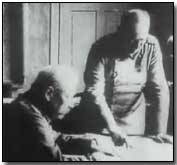Primary Documents - Erich Ludendorff on the Second Battle of the Aisne, 28 April 1917
 Reproduced below is the
text of
Erich Ludendorff's official announcement following the
Second
Battle of the Aisne and Third Battle of Champagne, dated 28 April 1917.
Ludendorff's statement highlighted the failure of the French-led offensive,
although he emphasised particular successes attained against British forces.
Reproduced below is the
text of
Erich Ludendorff's official announcement following the
Second
Battle of the Aisne and Third Battle of Champagne, dated 28 April 1917.
Ludendorff's statement highlighted the failure of the French-led offensive,
although he emphasised particular successes attained against British forces.
The French Army's failure to achieve success during the Aisne/Champagne offensive directly led to the replacement of the Commander-in-Chief Robert Nivelle. Nivelle, who had promised an end to the war through victory at the Aisne, was replaced by Henri-Philippe Petain.
Click here to read the reaction of the French War Minister, Paul Painleve, to news of the French Army's failure to gain success on the Aisne and at Champagne. Click here to read Kaiser Wilhelm II's reaction.
Erich Ludendorff on the Second Battle of the Aisne and Third Battle of Champagne, Official Announcement 28 April 1917
A very heavy drum fire, which was begun before daybreak over the whole front from Lens as far as Queant, was the prelude to a battle by which the British for the third time hoped to pierce the German lines near Arras.
By midday the great battle was decided by a heavy defeat of the British.
At dawn, on a front of about thirty kilometres, British storming columns followed curtains of steel, dust, gas, and smoke, which had been advanced by degrees. The weight of the enemy thrust north of the Scarpe was directed against our positions from Acheville as far as Roeux, where the battle raged with extraordinary violence.
The British forced their way into Arleux-en-Gohelle and Oppy and near Gavrelle and Roeux, occupied by us as advanced positions. They were met by a counter-attack by our infantry. In a severe hand-to-hand struggle the enemy was defeated. At some points he was driven beyond our former lines, the whole of which, with the exception of Arleux-en-Gohelle, is again in our hands.
South of the Scarpe, in the lowlands, a desperate battle also raged. In their wrecked positions our brave troops withstood the British charges, repeated several times. Here also the British attacks failed. On the wings of the battlefield enemy attacking waves broke down under destructive fire. The British losses were extraordinarily heavy.
April 28th was a new day of honour. Our infantry powerfully led and excellently supported by its sister and auxiliary arm, showed itself fully equal to its tasks.
Unfortunately, the violence of the enemy fire prevents us from repairing our trenches. Any attempt to do so merely exhausts the fighting force of our men prematurely. From the outset of a battle another method of construction must be applied.
A defensive zone extended in depth must be substituted for the old system of positions which can be destroyed by the enemy. This system, with its organizations concealed as far as possible from the enemy's observation, and with the troops holding it echeloned in depth so that their numbers, scanty in the front, increase progressively towards the rear, should enable us to pass from the defensive to the offensive with the troops from the rear.
During the battle all idea of having a continuous front-trench line must be abandoned. This must be replaced by shell crater nests, held by groups of men and isolated machine guns, disposed like the squares on a chess-board. The shelter provided by the shell-craters will be extended by tunnelling into the sides, or by linking them to adjacent craters by means of tunnels, supported by timber props.
The earth dislodged should be thrown into unoccupied craters near by, or, if the nature of the position permits it, should be spread over the ground between them. If timbered galleries cannot be built owing to the wetness of the ground, one must be content with very simple organizations to afford protection against shrapnel.
For this purpose old shelters, dug before the new order of things, may be used, but if none are available the men must obtain shelter as best they can on the open ground. There should be a line of barbed wire in front of the first line of shell-craters, and the empty craters in front of it should be girdled with wire to prevent the assaulting infantry from occupying them.
Source: Source Records of the Great War, Vol. V, ed. Charles F. Horne, National Alumni 1923
The financial cost of the war is said to have amounted to almost $38 billion for Germany alone; Britain spent $35 billion, France $24 billion, Russia $22 billion, USA $22 billion and Austria-Hungary $20 billion. In total the war cost the Allies around $125 billion; the Central Powers $60 billion.
- Did you know?
